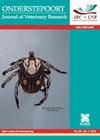Field Trial of Antibody Response To Inactivated Bacterial Vaccine in Young Holstein Calves: Influence of Animal Health Status
IF 1.6
3区 农林科学
Q2 VETERINARY SCIENCES
引用次数: 1
Abstract
Abstract Introduction Bovine respiratory disease (BRD) is one of the primary causes of death in young calves. Vaccination against infection by the common bacteria causing BRD is possible; however, the physical condition of the young calves that enables antibody production when stimulated by early immunisation remains to be elucidated. Material and Methods Healthy young female Holstein calves on a commercial dairy farm were fed a colostrum replacer and administered primary and booster immunisations with an inactivated vaccine against the bacterial pneumonia agents Histophilus somni, Pasteurella multocida and Mannheimia haemolytica. At each immunisation, the body weight and height at the withers were measured and the body mass index (BMI) was calculated. Blood was sampled immediately before immunisation and 3 weeks following the booster. The calves were divided into positive and negative groups based on the antibody titre at the final blood sampling. Maternal antibody titres at the primary immunisation and BMI, nutritional status and oxidative stress at both immunisations were compared between the two groups. Results Antibody titre at the primary and BMI at both immunisations were significantly higher in the positive than in the negative group (P < 0.05). Additionally, serum gamma globulin was significantly higher in the positive group (P < 0.05), indicating a strong correlation between maternal antibody and serum gamma globulin levels. Conclusion Elevated maternal antibody titre and higher BMI are positive factors for successful early immunisation, for which suitable colostrum may also be fundamental in young calves administered inactivated vaccines.雏牛对细菌灭活疫苗抗体反应的现场试验:对动物健康状况的影响
摘要简介牛呼吸道疾病(BRD)是幼牛死亡的主要原因之一。预防引起BRD的常见细菌感染的疫苗接种是可能的;然而,幼犊的身体状况,使抗体产生时,刺激早期免疫仍有待阐明。材料和方法在一个商业奶牛场喂养健康的年轻母荷斯坦小牛初乳替代品,并使用一种针对细菌性肺炎病原体嗜活组织杆菌、多杀性巴氏杆菌和溶血性曼海默病的灭活疫苗进行初级和加强免疫。在每次免疫接种时,测量体质量和马肩高,计算体质量指数(BMI)。在免疫接种前和加强接种后3周立即采集血样。根据最终采血时的抗体滴度将犊牛分为阳性组和阴性组。比较两组初次免疫时母体抗体滴度和两次免疫时的BMI、营养状况和氧化应激。结果免疫阳性组一次免疫抗体滴度和免疫后BMI均显著高于免疫阴性组(P < 0.05)。阳性组血清γ球蛋白显著升高(P < 0.05),提示母源抗体与血清γ球蛋白水平有较强的相关性。结论母源抗体滴度升高和BMI升高是早期免疫成功的积极因素,合适的初乳也可能是犊牛接种灭活疫苗的基础。
本文章由计算机程序翻译,如有差异,请以英文原文为准。
求助全文
约1分钟内获得全文
求助全文
来源期刊
CiteScore
4.30
自引率
0.00%
发文量
13
审稿时长
16 weeks
期刊介绍:
The Onderstepoort Journal of Veterinary Research, is the official publication of the Onderstepoort Veterinary Institute. While it considers submissions from any geographic region, its focus is on Africa and the infectious and parasitic diseases and disease vectors that affect livestock and wildlife on the continent.

 求助内容:
求助内容: 应助结果提醒方式:
应助结果提醒方式:


